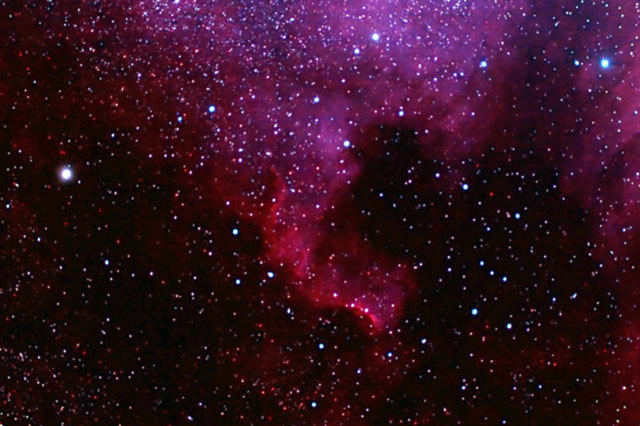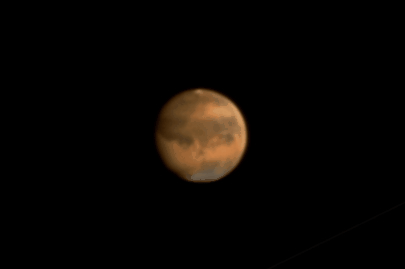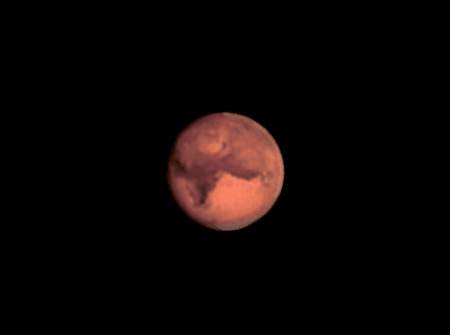
October 2005 Images
Page 2
______________________
The North American Nebula on 10/21/05
|
I have a friend who lent me a Meade LPI for testing as a guide camera. I also had a new setup to test for automatic exposure control with my Canon Digital Rebel. I am using DSLR Focus and a Shoestring Astronomy DSUSB setup to image with now. Unfortunately, the Meade LPI failed miserably as a guide camera. I wasted almost all the moonless period messing with it. In the end, I put my Toucam Pro back on and started using it with K3CCDTools as my guiding software. I had to use K3CCDTools with the LPI because that is the only software that supports it on a non-Meade platform. Since putting the Toucam in "RAW" mode, it is twice as sensitive and I can now guide with it better than I did before. K3CCDTools seems to function just as well as Guidedog, if not better, to boot. With the moon rising in the east, I said what the heck, let's try to image a nebula and see how well this new software/hardware combination works. After a few false starts and a cable problem with the DSUSB, I finally figured everything out and got out all the kinks. I managed to image the North American Nebula with sixteen, 120 second sub-images, all of which were automatically carried out by DSLR Focus and the Shoestring box. Check it out: |
|
The "Gulf of Mexico" of the North American Nebula on 10/21/05. Celestron 102mm F/5 refractor, Lumicon Deep Sky Filter and a Baader Fringe-Killer filter hooked to a Canon Digital Rebel. Toucam Pro webcam on my C-8 in RAW mode as a guide camera with K3CCDTools as the guiding software. Exposure was controlled automatically by DSLR Focus and a Shoestring Astronomy DSUSB. Sixteen, 120 second sub-images at 800 ISO stacked in IRIS with bias, flat and dark calibration and DDP. Richardson-Lucy deconvolution on the individual RGB layers, 4, 6 and 8 iterations, respectively. Neat Image for noise reduction. Lastly, Photoshop was used to color balance, resize and convert to JPEG. |
______________________
|
An almost perfect night of clear and still skies occurred on Friday, October 21/22, 2005. I was determined to test some equipment before moonrise, and then image Mars again. When the Red Planet had risen high enough in the sky, I got to work. Here is the results of my labor: |
|
Mars on 10/22/05, 06:00 UT (1:00 am CDT.) C-8 2000mm, Celestron Ultima 2X Barlow, Toucam Pro webcam in RAW mode. K3CCDTools was used for image acquisition. 547 Frames of 1194 stacked in Registax with wavelet processing. Further sharpening and color balance in Photoshop. South is up. |
|
2nd Image - Mars on 10/22/05, 06:23 UT (1:23 am CDT.) C-8 2000mm, Celestron Ultima 2X Barlow, Toucam Pro webcam in RAW mode. K3CCDTools was used for image acquisition. 500 Frames of 1194 stacked in IRIS with wavelet processing and unsharp masking. Further sharpening and color balance in Photoshop. South is up. |

|
Mars in motion on 10/22/05, 6:00 UT (1:00 am CDT.) to 9:00 UT (4:00 am CDT.) C-8 2000mm, Celestron Ultima 2X Barlow, Toucam Pro webcam in RAW mode. K3CCDTools was used for image acquisition. Seven images compose this animation sequence. The images were processed with either K3CCDTools, IRIS or Registax and animated with GIF Animator. South is up. |
______________________
Orion 120mm F/5 Refractor Test
|
A while back, I purchased a used Orion 120mm F/5 Refractor, along with a new Celestron 102mm F/5 refractor. I used it once for photography since I got it, so I figured it was time to do some more testing with it. Here are 2 images done with this scope: |
|
M-11, The Wild Duck star cluster on 10/22/05. Orion 120mm F/5, Canon Digital Rebel w/Lumicon Deep Sky Filter and Baader Fringe-Killer. Toucam Pro webcam in RAW mode and K3CCDTools for guiding. Exposure was three, 120 second sub-images at 800 ISO stacked in IRIS. Color balance, crop and convert to JPEG in Photoshop. |
|
M-27, The Dumbbell Nebula on 10/22/05. Orion 120mm F/5, Canon Digital Rebel w/Lumicon Deep Sky Filter and Baader Fringe-Killer. Toucam Pro webcam in RAW mode and K3CCDTools for guiding. Exposure was twelve, 120 second sub-images at 800 ISO stacked in IRIS. Color balance, crop and convert to JPEG in Photoshop. |
______________________
|
The seeing seems to be getting better and better for me as Mars nears it maximum size for this apparition. On 10/23/05, I fired up K3CCDTools to image the Red Planet again after guiding with it all evening for some Deep Sky imaging. I was very tired by that time, so I made one and only one capture. Here is the image I made off that AVI: |
|
Mars on 10/23/05, 06:15 UT (1:15 am CDT.) C-8 2000mm, Celestron Ultima 2X Barlow, Toucam Pro webcam in RAW mode. K3CCDTools was used for image acquisition. 300 Frames out of 1194 stacked in K3CCDTools with unsharp masking. Further sharpening and color balance in Photoshop. South is up. Click here to see the "overprocessed version." |
______________________
|
The image below was taken at the 23rd annual Deep South Regional Stargaze, near Kentwood, LA. I attended it this year for the first time in 19 years. I was all set to image Mars on the night of it's closest approach to Earth at the event. The seeing was not the best during the moment of closest approach, but I did manage to get some nice details of the Red Planet's surface 1 hour and 27 minutes later when Mars was higher in the sky and the seeing had much improved. |
|
Mars on 10/30/05, 05:48 UT (12:48 am CDT.) C-8 2000mm, Celestron Ultima 2X Barlow, Toucam Pro webcam in RAW mode. K3CCDTools was used for image acquisition. 300 Frames out of 1194 stacked in IRIS with wavelets and unsharp masking. Further sharpening and color balance in Photoshop. South is up. |

|
Animation of Mars rotating on 10/30/05, 05:15 UT (12:15 am CDT) to 06:59 UT (1:59 am CDT.) Six images are in the sequence and all were taken with a C-8 2000mm F/10, Celestron Ultima 2X Barlow, Toucam Pro webcam in RAW mode. K3CCDTools was used for image acquisition. 300 Frames out of 1194 stacked in K3CCDTools with unsharp masking. Further sharpening and color balance in Photoshop. South is up. |
______________________
The Flame Nebula
and the Horsehead
Nebula at the
DSRSG
Oct 28-30th, 2005
|
The 23rd annual Deep South Regional Stargaze at Camp Ruth Lee near Kentwood, LA was the location where this next image was taken. It was crystal clear, dark skies with only a faint light dome to the south from Baton Rouge, LA. The seeing varied from poor on the first night to fair/good to very good on Saturday night, October 29/30. Boy, but did it get cold! It was so cold on Friday night, October 29th that I had frost on my telescope and equipment cases when I finally turned in at about 5:00 am on Saturday morning. I must have been crazy to stay up that late! I think this guy named Chris Collins and I were the last men standing on both primary nights of the star party. I know for a fact we were on Sunday morning, because it was daylight and there was no one else to be seen but him and I. We were doing planetary with his big Tak refractor, soaking up Saturn, even during strong twilight. I was taking lots of pictures, but with only moderate success. I was plagued by equipment guiding problems, cable issues with my remote shutter, dew really bad, etc, etc. Anyway, I did manage to get a couple usable pictures, as well as get some decent planetary images like the above Mars images. Below is the last image of the bunch that I took at the star party. As you can see, dew got me a little, but it still made a pretty picture: |
|
The Flame Nebula and the Horsehead Nebula on 10/30/05. Orion 120mm F/5 refractor, Canon Digital Rebel w/Lumicon Deep Sky Filter and Baader Fringe-Killer. Toucam Pro webcam in RAW mode and K3CCDTools for guiding with a C-8. Exposure was ten, 180 second sub-images at 1600 ISO stacked in IRIS. Neat Image for noise reduction. Color balanced, cropped and converted to JPEG in Photoshop. |
______________________
The Andromeda
Galaxy at the DSRSG
Oct 28-30th, 2005
|
My favorite galaxy of all time has got to be the Andromeda Galaxy. While at the DSRSG, I decided that I would devote some time to try and get a good image of this grand galaxy. Here is what I got while at the star party: |
|
The Andromeda Galaxy on 10/30/05. Celestron 102mm F/5 refractor, Canon Digital Rebel w/Lumicon Deep Sky Filter and Baader Fringe-Killer. Toucam Pro webcam in RAW mode and K3CCDTools for guiding with a C-8. Exposure was twelve, 300 second sub-images at 800 ISO stacked in IRIS. Neat Image for noise reduction. Color balanced, cropped and converted to JPEG in Photoshop. |
______________________
The M33
Project:
Images from the DSRSG
Oct 28-30th, 2005
|
The project I started with M33, "The Pinwheel Galaxy" near the beginning of the month is near completion. I took advantage of the clear and very dark skies at the Deep South Regional Stargaze, 2005 to image M33 again. This time, I got five, 5 minute exposures of the object at 1600 ISO. Here is the result of stacking those five with the nineteen images I already had: |
|
The "Pinwheel" Galaxy on 10/30/05. Celestron 102mm F/5 refractor, Canon Digital Rebel w/Lumicon Deep Sky Filter and Baader Fringe-Killer. Toucam Pro webcam in RAW mode and K3CCDTools for guiding with a C-8. Exposure was five, 300 second sub-images at 1600 ISO stacked with nineteen, 180 second subs from 10/08/05. Both sets were independently stacked in IRIS and then combined in Photoshop. Neat Image for noise reduction. Color balanced, cropped and converted to JPEG in Photoshop. |
______________________
The Helix Nebula:
Images from the DSRSG
Oct 28-30th, 2005
|
I finally was able to finish processing this image of the Helix Nebula on 11/17/05. I took this image while at the DSRSG on the first night of the star party. I had some problems with the background and noise with this one. Everything I tried did not fix it. PixInsight, from Pleiades Astrophoto got me out of a jam with this image. I had tried this software way back, but I did not know what I was doing back then. LoL! Anyway, here is the completed image: |
|
The Helix Nebula on 10/29/05. Celestron 102mm F/5 refractor, Canon Digital Rebel w/Lumicon Deep Sky Filter and Baader Fringe-Killer. Toucam Pro webcam in RAW mode and K3CCDTools for guiding with a C-8. Exposure was fifteen, 300 second sub-images at 800 ISO stacked in IRIS. PixInsight for noise reduction and background subtraction. Color balanced, cropped and converted to JPEG in Photoshop. |
All Images Copyright © 2005 Mike Broussard.
All rights reserved.
To send comments or for more information, please email me at
mike@synergyitg.com.
Visitors since October 22, 2005